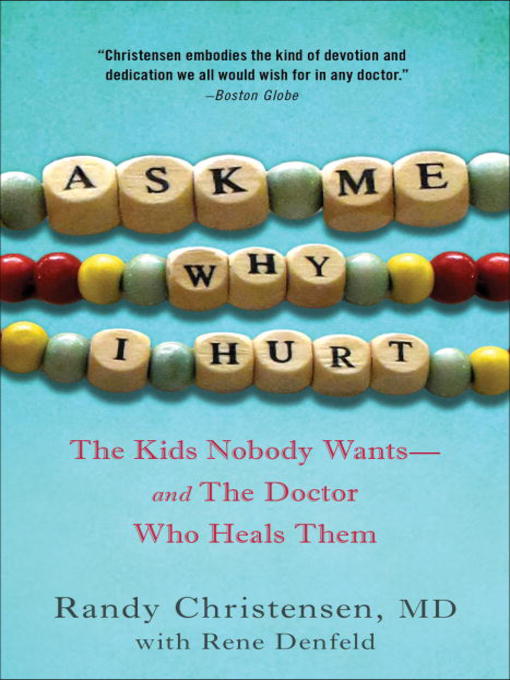
Ask Me Why I Hurt
The Kids Nobody Wants and the Doctor Who Heals Them
بچههای هیچ کس دوست ندارند و دکتر چه کسی آنها را درمان میکند
کتاب های مرتبط
- اطلاعات
- نقد و بررسی
- دیدگاه کاربران
نقد و بررسی

February 14, 2011
Phoenix pediatrician Christensen recounts the past decade spent treating Arizona's homeless youth in his "Big Blue" van in this inspiring account of a doctor who truly puts his patients' needs first. Always drawn to community health care, Christensen—a doctor at the prestigious Phoenix Children's Hospital—jumped at the chance to head a mobile unit that would bring basic medical needs to the area's large population of homeless teenagers. Initial funding came through the Children's Hospital and generous private grants, and Christensen, along with a no-nonsense nurse and cabinets full of basic medication, crammed into a converted Winnebago and drove off to abandoned parking lots to find patients. Nothing prepared him for the onslaught of misery and poverty, as homeless kids came with complaints ranging from infected insect bites to STDs acquired from prostitution. Christensen became not only an advocate within the community by helping the youths find beds in shelters but also offers his expertise in mobile health care to other crisis areas, volunteering in Louisiana after Hurricane Katrina. With just the right blend of personal history, patient anecdotes, and relevant suggestions for health care improvement, Christensen's memoir is an uplifting yet sobering read.

February 1, 2011
A physician's memoir of his years working with homeless youth.
In 2000, while working at Arizona's Phoenix Children's Hospital, Christensen asked to be assigned a daunting task—leading a mobile health-care unit aimed at serving homeless children. In the world of modern medicine, this was not the obvious way to climb the career ladder toward regular hours and a hefty salary. With a small group of passionately committed providers, Christensen turned this small community-service unit into an integral part of the urban medical landscape. Along the way, he struggled to balance the emotional and psychological demands of treating vulnerable children with the pressures placed on his marriage and family life. Ultimately, the children he encountered on the streets of Phoenix become the real subjects of his memoir, co-authored with journalist Denfield (Kill the Body, the Head Will Fall: A Closer Look at Women, Violence, and Aggression, 1997, etc.). Christensen's many subjects include: Sugar, the pregnant young prostitute who found her way to new life; the abused and neglected young man who discovered love in a community home; and a mentally ill young woman whose tragic murder resulted in part from the bureaucratic tangles that prevented anyone from truly helping her. The title of the book comes from the bracelet worn by one patient who was unable to tell the story of the systematic abuse that left her homeless. The author provides numerous heart-rending stories, yet, for such a serious subject, the narrative is written with obvious joy and an impassioned optimism for what health-care providers and communities can achieve.
Refreshingly free of moralistic lectures about the collective failure of the American health-care system, Christensen's book is a wry, sincere story that makes the need for change inescapably obvious.
(COPYRIGHT (2011) KIRKUS REVIEWS/NIELSEN BUSINESS MEDIA, INC. ALL RIGHTS RESERVED.)

November 1, 2010
He's been declared a "CNN Hero" and a "Hero Among Us" by People magazine. Why? Phoenix pediatrician Christensen roams the streets in his Crews'n Healthmobile, providing free mobile health care to thousands of the city's homeless and at-risk adolescents each year. Not just inspiration but a wake-up call for our entire health system; expect some buzz.
Copyright 2010 Library Journal, LLC Used with permission.

April 15, 2011
As a casualty of high unemployment rates and home foreclosures, the recent blight of homelessness has been devastating to Americas children. By some estimates, close to 1.5 million children and teens now live on the streets, most without adequate nutrition or medical care. For those afflicted with everything from ear infections to STDs, Phoenix-area pediatrician Christensen has been a godsend, providing antibiotics and immunizations from a converted Winnebago dubbed the Crewsn Healthmobile. In this alternately heartwarming and heartrending memoir, Christensen recounts the tribulations involved in keeping his clinic-on-wheels funded and rolling while treating thousands of physically and psychologically wounded adolescents. Among the refugees of broken homes the reader will encounter and care about as they recover are Mary, raped by her stepfather; Sugar, a bubbly teen forced into prostitution at 12; and Daniel, an Alabama transplant suffering from abuse-inflicted brain damage. Together, with Christensens touching side account of his own family challenges, these stories should encourage other large communities to follow the Healthmobiles inspiring lead.(Reprinted with permission of Booklist, copyright 2011, American Library Association.)

























دیدگاه کاربران